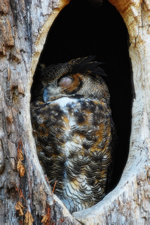
Great-horned Owl
Wikipedia
|
Female owls are larger and heavier than the males of their species.
A Great Horned
Owl weighs about 3 ½ - 4 pounds. Its two eyes together weigh about
25.7 grams (almost an ounce), more than the eyes of a 200-pound
human.
Snowy Owls weigh about 4 pounds. But the Great Gray Owl, which is larger
than the Great Horned or Snowy Owl, weighs only 2-3 pounds. A starving
Great Gray Owl was recovered that weighed only ¾ pound.
Owl necks are longer and skinnier than they look. The long, thick feathers
that cover the neck make it look short and fat. Owls can
twist their necks to turn their heads about 270 degrees—about ¾
of a full circle—without moving their shoulders.
Owls don't have eyeballs. The eyes are long and shaped more like a tube.
Owl eyes can't turn in their sockets because of this shape.
Owls and the related nightjars (including Whip-poor-wills and nighthawks)
are among the only birds that have a larger upper eyelid than lower eyelid.
That, their forward-facing eyes, and feather-covering at the base of their
beak, make them appear more human-like than other birds. Their
human-sounding voices are one reason so many cultures throughout
the world have stories and folklore about owls.
Owls can see in the daytime. Their pupils don't get as small as ours in
bright light, so to block out the extra light, they often close their
eyes half-way or more. They may look sleepy or even half asleep when really
they are wide awake and alert.
Vision cells (called rods and cones) are in the retina of all animals.
But birds and primates (including humans) have a special area in the
retina called the fovea where these vision cells are especially concentrated.
In hawks and owls, the fovea is on the upper part of the retina, so things
below the owl appear exceptionally clear. This helps them hunt on the ground.
When owls close their eyes half way, they block out the sky and some of
the sunlight, but can still see the ground below perfectly.
In darkness, or when prey is hidden by snow or tall weeds, owls need to
pinpoint both the direction of and the exact distance from their prey.
(In total darkness, if they grab too short, they'll miss and
could crash on the ground.) Owl ears are crooked-one is further forward
and one higher than the other. When an owl hears the sound of a mouse
as loud as possible in both ears, it has the direction. And because the
ears are crooked, the sound of the mouse reaches one ear a split second
before it reaches the other. That difference allows the owl's brain to
calculate the exact distance from the mouse.
Owl feathers are velvety thick and soft, absorbing a lot of the sound
of their flight. Their wings are big for their weight, allowing them to
beat slowly as they fly, which makes their flight even quieter. And their
primary feathers (the wing feathers that stick out like fingers) have
a comb-like edge, breaking the whoosh of each wingbeat into hundreds of
tinier whooshes. This silent flight has two purposes. First, it makes
it easy for the owl to sneak up on its prey. Second, it allows the owl
to keep hearing the prey in the dark, even as the owl flies in.
Owl stomach juices can't dissolve bones, fur, feathers, or teeth. If these
parts got into the intestines and splintered, the owl could die. So all
these parts get stuck in a chamber of the owl's stomach called the gizzard.
About once a day the owl's stomach contracts, squeezing all the liquid,
soupy food into the intestines, and then the owl spits up the left over
fur, bones, feathers, and teeth in a clean rounded chunk called a pellet.
Owls have four toes-three in front and one behind. But one of an owl's
front toes is opposable, like our thumb. When an owl perches or grabs
prey, it puts its thumb toe backward. When you look closely at photos
of live owls, see if you can see the two toes on each foot.
Most owl's toes have feathers all the way down to the long, sharp claw.
These feathers protect the feet from cold and from tiny ice splinters
when they grab prey under snow.
The tiniest owl is the Elf Owl, which is 5 - 6 inches tall and weighs
about 1 ½ ounces. (A quarter-pound hamburger, without buns, pickle
or ketchup, is heavier than two Elf Owls.)
Most owls don't make their own nest. They usually nest in a tree cavity
or in an old crow, raven, or hawk nest. The Elf Owl usually nests in woodpecker
holes dug into large cactus plants.
Some owls migrate every year, like the Saw-whet and Long-eared Owls. Some
stay in the same area all year, like the Great Horned and Barred Owls.
Some move south irregularly. Every year a few Snowy Owls retreat from
the Arctic, but a great many fly south during years when their favorite
food supply, little mammals called lemmings, drops in number. |



